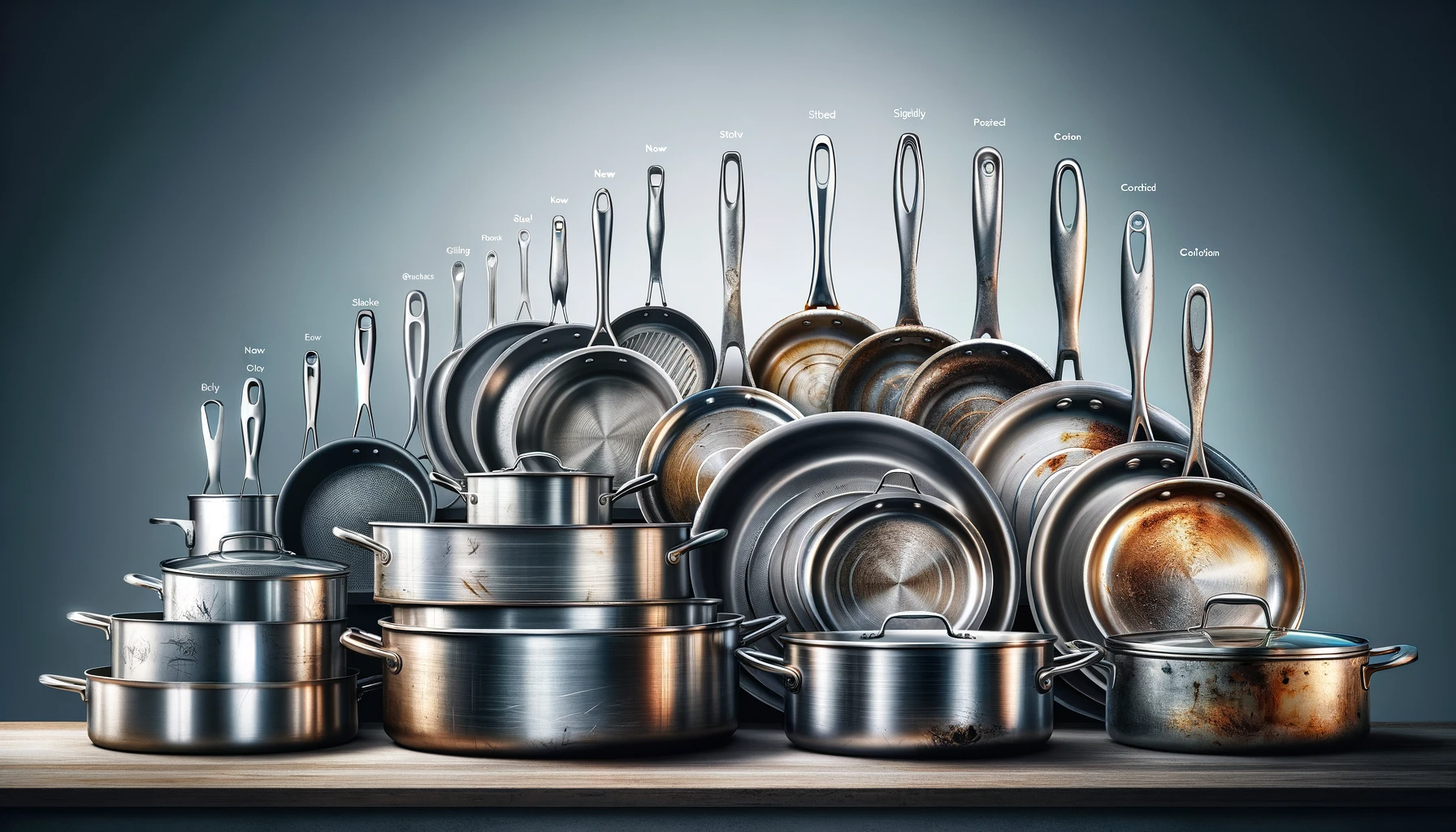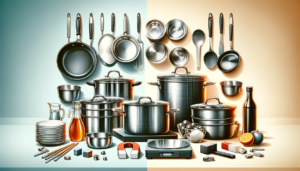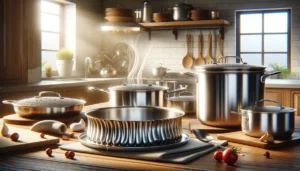Have your stainless steel pans lost their shine? Food sticking or burning more often? Don’t ignore these signs you need replacements.
Stainless steel cookware provides durability but still gets wear and tear damage over time.
Knowing when to swap pans ensures cooking precision and safety.
Let’s explore the top indications your pans need retirement from kitchen duty and how to evaluate their current effectiveness.
Signs It Is Time to Replace Your Stainless Steel Pans
The top signs it is time to replace your stainless steel pans are warping, loose handles, discoloration from corrosion, deep scratches and pitting, and ineffective cooking including uneven heating and longer cook times.
When you notice these issues appearing, it indicates your cookware reached the end of its lifespan for reliably safe usage.
We’ll explore these declining indicators more below on when retirement is prudent for daily-use pans.
1. Warping and Dents

Stainless steel pans are designed to distribute heat evenly across the cooking surface.
However, over time with repeated high heat exposure and impact from utensils, pans can become warped or develop dents.
If your stainless steel pans have visible warping across the bottom or sides of the pan, it is likely time to replace them.
Warping prevents even direct contact with the stove heating element which leads to inconsistent cooking results.
Food is more likely to burn in areas that dip down and make contact while undercooked in raised warped sections.
Additionally, large dents on the cooking surface or walls of stainless steel pans interfere with effective heat conductivity.
The damaged sections absorb less heat compared to surrounding areas which can lead to scorching if the temperature is high enough to burn in the smooth sections before dens sufficiently heat.
Just like warping, this diminishes cooking precision and makes consistent broiling, searing and sauteing difficult.
The impact that created the dent likely also causes the protective layer inside stainless steel pans to separate or crack.
2. Discoloration and Corrosion

Brand new stainless steel has a uniform light silver metallic shade across the entire pan surface and walls.
This sleek steel color should not change over time with proper care.
However, if you notice brown, blue, rainbow or other discoloration developing, it is likely caused by corrosion to the interior steel.
Stainless steel gets its name from having a minimum of 10.5% chromium layer which provides corrosion resistance.
The layer is stable with initial oxidation but damage to that film over years of use exposes the steel underneath to moisture and acids from food.
Corrosion appears with prolonged contact between stainless steel and produce acids, salt, or very alkaline dish soaps.
You may notice corrosion after cooking many tomato sauce dishes without fully neutralizing the acidity prior to storage.
Using highly salted water to boil pasta that evaporates and leaves residue behind can also instigate corrosion over time
3. Loose or Ill-Fitting Handles

Stainless steel pans typically have metal handles riveted to the exterior walls with strong structural reinforcements.
Quality pans designed for longevity have tightly secured handles that do not wiggle or rotate.
However, repeated heating and cooling of pans can weaken metal and connections over many years especially when exposed to dropped impacts.
If your stainless steel skillet or saucepan handle feels at all loose with movement when grasped and manipulated, it indicates full separation from the pan body is inevitable.
As handles continue detaching from cookware, the structural weakness poses a significant injury hazard.
Loose handles can unexpectedly give way when lifting heavy pans full of scalding liquids or food.
The pan contents could spill out seriously burning you.
Even if the handle just shifts slightly in your grasp, it becomes difficult to adequately control the pan stability and positioning.
This could lead to inadvertent spills or contact with stove heating elements.
4. Scratches and Pitting

In the short term, minor scratches and scuffs on the surface of stainless steel pans is normal wear and tear.
However, deep grooves from years of abrasion using harsh scouring scrubs or metal utensils give spaces for food residue and bacteria to accumulate even after thorough washing.
These grooves cannot be effectively cleaned fully since they have texture that traps particles.
Over time, scratches degrade into permanent pitting corrosion which causes tiny perforations and roughened cooking surfaces.
If you notice any scratches becoming darker in color or deeper in texture, bacteria is likely taking hold even if not visible.
Pitting corrosion looks like scattered tiny dark spots or craters in the steel.
Both scratched grooves and pitted perforations make cleaning stainless steel pans extremely difficult even with careful scrubbing using non-abrasive dish soap and sponges.
Since food remnants get trapped, this causes unwanted odors and poses illness risk if bacteria transfers to the next foods cooked.
Deep scratches that snag cleaning tools and visible dark pitting mean it is advisable get a replacement stainless steel pan.
5. Ineffective Cooking Performance

High quality stainless steel pans allow even cooking across the exterior bottom and up extending walls.
You can sear, brown, and broil without items burning in hot spots or taking much longer than expected to reach desired finish texture and color.
However, this consistency diminishes as pans get damaged through repeated use over many years.
You are likely due for replacement stainless steel cookware if food is scorching in areas despite moderate stove temperature or if uniform cooking takes excessively long even at higher heats.
If your pans have visible deterioration like warping, corrosion, pitting, scratches etc described in prior sections, the capacity to effectively cook has been impacted.
Food particles get trapped in damaged areas which decreases heat absorption.
You have to crank up the burner temperature attempting to evenly finish dishes but end up with blackened sections before the majority reaches optimal doneness.
If you notice the window between perfection and burnt is a few seconds versus several minutes in the past, your pans are no longer able to adequately perform at any stove setting.
6. Cracked Surface

While stainless steel itself does not crack under normal home kitchen conditions, the protective inner layer that gives the “stainless” ability does get damaged from drops, overheating, and abrasions over time.
Minute cracks expose the carbon steel core metal underneath leading to oxidation damage.
You may notice very fine lines across the cooking surface or see cracks radiating from impact dents and scratches that worsen with continuous use.
Even small hairline cracks provide enough space for water, food residue and cleaning solutions to leach underneath the stainless barrier.
This moisture exposure spreads oxidation outward from the initial crack entry source leading to corrosion, peeling, and permanent dark pitted perforations.
Food likely sticks more stubbornly to cracked cookware bottoms making cooking performance inconsistent and difficult plus promote bacterial accumulation risks despite careful cleaning attempts.
Even if cracks are not wide enough currently to seriously hamper function, they indicate progression to further breakdown.
Once the interior stainless layer fails with cracks, replacement is the only remedy for damaged pans.
Attempts at patching cracks inevitably still allows debris and liquid below the barrier leaving you with lackluster stainless steel pans unsuitable for quality cooking.
Conclusion
Ultimately, stainless steel pans don’t last forever.
Keep an eye out for warping, scratches, loose handles, cracks, and pitting as well as declining cooking performance.
These are clear indicators it is time to invest in new stainless steel cookware for consistency, reliability and to prevent safety issues.
Properly caring for pans helps prolong their lifespan but replacement is inevitable with daily use over many years.



